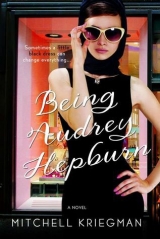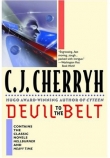
Текст книги "Being Audrey Hepburn"
Автор книги: Mitchell Kriegman
Жанры:
Роман
,сообщить о нарушении
Текущая страница: 24 (всего у книги 24 страниц)
69
“You better hurry or you’ll be late,” Jess called as I slipped on a floral top and Designer X’s first pair of jeans—still in prototype actually. Her coated skinny jeans felt so wonderful, they made you want to dance.
A light evening breeze was flowing through the open window in the guest room. As I snapped the window latch shut, I noticed the yellowed front page of The New York Post tucked in a shelf in the corner. I couldn’t believe Jess still had a copy.
Throwing a few things in one of Jess’s monster bags, I dashed out of her West Village apartment to catch the PATH train at Christopher Street for my nightly reverse commute.
Truthfully, all the notoriety didn’t hurt my blogger following. After a while the fan mail came back. You can’t win an argument with a troll, so I never tried, and slowly they faded to the bottom of the comments list.
“I have more than a grudging admiration for you,” one commenter wrote. “Fabulously brazen,” another said. Flo stood by me, thankfully. She didn’t mind how my fraudulent behavior exploded our “brand.” Honestly, my brand was very much in keeping with who I was. Even if I wasn’t who I said I was. As you can guess my clicks and visits skyrocketed—everyone had to check it out.
I gunned the Purple Beast and drove out of the parking lot by the Grove Street PATH station and made my way down the parkway, just as I had done every night for the last few weeks. One more time and I could take a break.
The New York district attorney’s office examined my case and determined that I hadn’t gained any money or valuables from the hoax. In fact, I had even managed to lose a valuable bracelet. So I hadn’t actually committed a prosecutable crime. I fell back on Nan’s advice and apologized like mad, promising to never, ever do it again.
The investigation was much harder on Nan. She’s forgiven me over and over, but I couldn’t stop feeling terrible about it. If Dahlia hadn’t hired the private detective to investigate me, I don’t think Nan would have ever told us her secret.
Everybody was astounded that the little ole lady in apartment 5A of Montclair Manor had been a major fugitive all that time. Only Betty claimed that she had been suspicious. She told channel 2 news that she knew Nan was hiding something. One or two of the other blue-haired ladies complained that she was a card shark and cheated at bingo.
Turns out, Grandpa was a well-known member of Cosa Nostra from the fifties who mysteriously dropped out of sight. Frank Wachowicz, aka Sammy Graziano, was known as the Gentleman Gangster, famous for dressing well and carrying his gun in a paper bag so that when he walked down the street, it looked like he was bringing you a sandwich.
The feds were so embarrassed that he had been living across the river in plain sight they claimed he was a secret witness under protection who sang like a canary.
“Grandpa was too honorable for that,” Nan told me. It was the only time I had ever seen her angry. “My Sammy quit the mob for me, so we could have a normal life. Sure, there was a rule, the omertà, but, like a lot of rules, it was made to be broken. Your grandpa just knew how to make it work.”
The New York Post reporter dug up some astonishing black-and-white pictures I had never seen of Nan and Grandpa at the Stork Club and the El Morroco, out on the town in the late fifties. Jess and I would sit around with the photos and pick out the actual dresses we had redone.
In those pictures you could see what Nan was really like in her younger days. Sitting with Ida Lupino, Josephine Baker, Diana Vreeland, and an occasional Kennedy, she was one of those exquisite creatures whose intelligence was as impressive as her surpassing elegance. She wasn’t just hanging passively on Grandpa’s arm. You could see her active engagement with everyone around her.
Judge Ruston gave Nan a mere slap on the wrist, despite Dahlia’s district attorney friend and the efforts of the DOJ’s finest prosecutors. It was nearly impossible to prosecute her with Grandpa gone.
I overshot the parking space as usual, screeching on the brakes. I still couldn’t control the Purple Beast. One tire was up on the parking block, but it was only one. I had to hurry; the band was already near the end of their set.
“I’m impressed with how you’ve utterly messed everything up,” Isak said when we finally got together. I was so happy to see him that all I could do was agree.
“Seems like you have some fabulous shoes to fill,” quipped Isak, referring to Nan’s glamorous past. Even so, I apologized to Isak for being such a phony. He was utterly dismissive.
“Sure you’re a phony,” he said. “But you’re a real phony. Not like all the phonies these days. I find it absolutely exciting that there are still people in the world who manage to have these thrilling, preposterous adventures. Besides, you know, we’re all fakes.”
The outrage and publicity hadn’t affected Jess at all. Her Designer X line began to thrive immediately. It certainly helped that she had Isak Guerrere as her partner.
Mom is still a worry. She was the most emotional one about the whole Mafia thing, finally coming to grips with how terrified she had been as a child. They had to keep moving from house to house in the middle of the night, and she had to change schools all the time. She knew something was wrong, but no one would talk about it.
There was a waterfall of tears the night at the hospital when Mom and Nan had the heart-to-heart they should have had decades ago. Nan hugged Mom to tell her how sorry she was that she put her through so much and never told her why. That night, it felt like some big thing in the world had changed. A missing connection had been restored that made us a family again. Now she just had to get through the operation.
I slipped by the guys at the door, who didn’t even bother to ask—they were used to me showing up late.
Courtney was the first one to tell me about Monica and Jake. Turns out Monica frequented Harris’s Riverside Bar and Grill. That’s where Courtney bartends. Monica would come in there on weekends with her two kids and her computer-nerd husband for brunch. She was married and lived in Weehawken. Courtney and Monica had struck up a friendship. Monica talked about this hot band she represented and what a hunk the lead singer was. It took a while for Courtney to put two and two together. The cowboy thing was an act for her music-management business, which she was devoted to almost as much as she was to her husband and two kids. She was actually a typical Jersey soccer mom wearing black-framed glasses and sweatpants.
The band had already finished the set by the time I made my way inside. The packed crowd was asking for another encore.
The truth is that I never felt like myself until I put on the Givenchy. It seems crazy that I had to go to such lengths to find out who I really was. But I guess something had to change. Something had to lift me up to get me out of where I had been.
“Sometimes good things aren’t always so great,” as Nan used to say, “and bad things often turn out to be good for you.” I never understood that when I was a kid, but I certainly do after all that has happened.
As I wormed my way through the crowd to the corner of the stage by the soundboard, Jake came out by himself, plugged into his amp, and gave me a wink as he started to sing.
One night the look in your eyes was like a light.
It shined so bright that I couldn’t see,
That … one … night.
The whole audience sang along to the chorus as it repeated.
That … one … night.
The NYPD took a long time to finalize their report on the investigation, and here’s what I learned: if you pretend to be another real person it’s fraud. And if you pretend to be a doctor and treat someone it’s a crime. But if you pretend to be Audrey Hepburn, there’s no law against that.
You know the clothes you wear?
The color in your hair?
You were so damn fine,
That … one … night.
Jake grabbed me and pulled me up on the stage, in front of the whole crowd at Reilly’s, as the rest of the band came out and played the last verse, that strand of black hair falling across his face as he leaned over to kiss me.
It was a condition of our reconciliation. I had to be there every night for the encore at his last gig at Reilly’s to make up for, well, you know. Can’t say I minded at all.
Time heals everything; it truly does.
Time heals everything, but love.
I held on to him even after the song stopped, his heart still beating fast from the show. His whole body was warm. The audience felt so far away.
“So Lizzy, you ready to take off?” he whispered in that soft Jersey voice as the audience shouted.
I nodded.
We were taking Jake’s ’76 BMW and going for a little road trip, stopping wherever and whenever we wanted to.
Just me and Jake.
And his guitar of course.
I wondered if he could play “Moon River.”
Acknowledgments
To say I owe a debt to Truman Capote is like saying a flea owes a debt to a dog. As a young disaffected writer from the South I read Capote with awe and wonder. It may be obvious that I am beholden to the author who created Holly Golightly and wrote the novella Breakfast at Tiffany’s, as well as to screenwriter George Axelrod and director Blake Edwards, who adapted Capote’s literary work for film. Discerning readers who know the novella and the movie adaptation well will find a multitude of allusions, references, homages, tributes, and deliberate echoes of those works and other movies from Audrey Hepburn’s career woven into the scenes and dialogue of this book. I’m grateful to the bloggers and online fans for their inspiration in culling the most intriguing aspects of Audrey Hepburn’s career.
I would also like to acknowledge the support of a number of generous people who I am lucky to have known and benefited from: novelist Jean Craighead George, my sole source of encouragement for decades; New Yorker fiction editor Veronica Geng, who early on helped me find a writing voice that it has taken a lifetime to recover; my editor, Brendan Deneen, who gave me a cupful of commas and told me to write three more chapters—I’m grateful for his faith in my abilities and his naive belief that I would finish on time; Barbara Marcus, publisher of the Children’s Division at Random House, whom I was fortunate to have found during a brief window in her extraordinary career—her warmth, encouragement, and expertise were crucial to my efforts; Carla Riccio, former Dial Press editor, who worked almost as hard on this manuscript as I did and pointed me down the path toward that “sensuous journey with words” so many people talk about, which I was stumbling around, hoping to find; the Southampton Review editor Lou Ann Walker, who taught me the ropes in this and many other literary and life endeavors; costume designer Lisa Lederer, whose joie de vivre and original take on fashion has informed this book throughout; Amy Berkower at Writers House, Ken Wright, now publisher of Penguin Children’s Books, and Nichole Sohl at St. Martin’s, all of whom launched me on my way and carried me through the storm; Jan Kroeze, lighting designer and director of photography, and Michele Pietra, fashion stylist and couture expert, who gave me invaluable insider advice; Gloria Henn, who came into my life to help me build an empire and made me realize my job was to tear one down instead; Fred Perkins and Henry Guberman, who enabled me to find the room to do so and write again; Anne Richards, who has always been a compass from our earliest days working together; and film and stage director Mike Nichols, who likely has no idea who I am or where we met but who, in a casual conversation, mentioned a bit of advice that he used to try to help his children understand, which I couldn’t stop thinking about and became instrumental to the story of this novel; and finally my kids, Mac, Jake, and Tess, whom I adore—if it weren’t for their lively, wonderful lives and their endless needling and condescension, I wouldn’t have worked so hard to succeed. Without the help of these wonderful people, this book would not have been possible.
Finally, the entire book attests to the enduring legacy of Audrey Hepburn, who intuitively and through her own self-design became the first movie star and actress of the poststudio age. Her personal transformation—the Pygmalion Effect, some call it—stands as a model for everyone, especially those young women living in the gray suburbs and forgotten inner cities aspiring to become something better and happier, intent upon the dangerous work of reinventing oneself despite whatever troubled origins they may have. Audrey Hepburn represents nothing less than the creative transformation of self and will always be an icon for others more for that reason than for her compelling talents as an actress, her advocacy for the world’s children, or her sense of style.
About the Author

MITCHELL KRIEGMAN has been published in The New Yorker, National Lampoon, New York Press, Glamour, and Harper’s Bazaar. A winner of four Emmy Awards and a Directors Guild Award, he was the creator of the classic groundbreaking television series Clarissa Explains It All, as well as executive story editor on Ren & Stimpy, Rugrats, and Doug. Kriegman was also a writer and filmmaker for Saturday Night Live.
www.beingaudreyhepburn.com
This is a work of fiction. All of the characters, organizations, and events portrayed in this novel are either products of the author’s imagination or are used fictitiously.
THOMAS DUNNE BOOKS.
An imprint of St. Martin’s Press.
BEING AUDREY HEPBURN. Copyright © 2014 by Mitchell Kriegman. All rights reserved. For information, address St. Martin’s Press, 175 Fifth Avenue, New York, N.Y. 10010.
www.thomasdunnebooks.com
www.stmartins.com
Cover design by Lisa Marie Pompilio
Cover photographs: Audrey Hepburn © Iuliia Stepashova/Shutterstock.com; jewelry store © Tupungato/Shutterstock.com
eBooks may be purchased for business or promotional use. For information on bulk purchases, please contact Macmillan Corporate and Premium Sales Department by writing to MacmillanSpecialMarkets@macmillan.com.
The Library of Congress Cataloging-in-Publication Data is available upon request.
ISBN 978-1-250-00146-7 (hardcover)
ISBN 978-1-250-01349-1 (e-book)
e-ISBN 9781250013491
First Edition: September 2014








